Automatic RENAULT MEGANE 2017 4.G Repair Manual
[x] Cancel search | Manufacturer: RENAULT, Model Year: 2017, Model line: MEGANE, Model: RENAULT MEGANE 2017 4.GPages: 346, PDF Size: 7.04 MB
Page 213 of 346
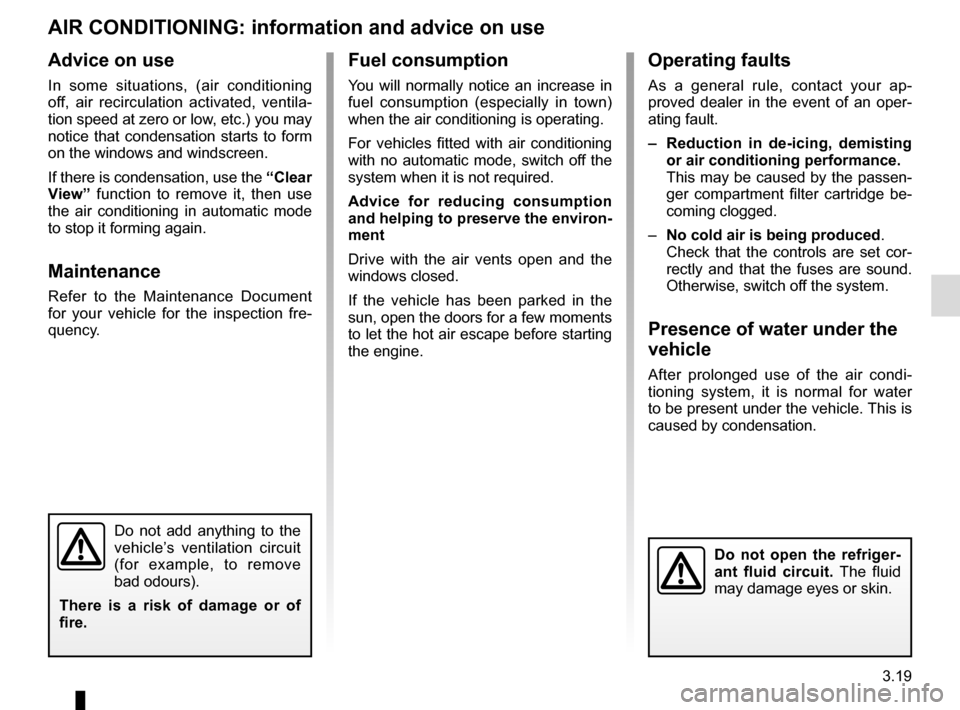
3.19
Operating faults
As a general rule, contact your ap-
proved dealer in the event of an oper-
ating fault.
– Reduction in de-icing, demisting or air conditioning performance.
This may be caused by the passen-
ger compartment filter cartridge be-
coming clogged.
– No cold air is being produced .
Check that the controls are set cor-
rectly and that the fuses are sound.
Otherwise, switch off the system.
Presence of water under the
vehicle
After prolonged use of the air condi-
tioning system, it is normal for water
to be present under the vehicle. This is
caused by condensation.
AIR CONDITIONING: information and advice on use
Do not open the refriger-
ant fluid circuit. The fluid
may damage eyes or skin.
Fuel consumption
You will normally notice an increase in
fuel consumption (especially in town)
when the air conditioning is operating.
For vehicles fitted with air conditioning
with no automatic mode, switch off the
system when it is not required.
Advice for reducing consumption
and helping to preserve the environ-
ment
Drive with the air vents open and the
windows closed.
If the vehicle has been parked in the
sun, open the doors for a few moments
to let the hot air escape before starting
the engine.
Advice on use
In some situations, (air conditioning
off, air recirculation activated, ventila-
tion speed at zero or low, etc.) you may
notice that condensation starts to form
on the windows and windscreen.
If there is condensation, use the “Clear
View” function to remove it, then use
the air conditioning in automatic mode
to stop it forming again.
Maintenance
Refer to the Maintenance Document
for your vehicle for the inspection fre-
quency.
Do not add anything to the
vehicle’s ventilation circuit
(for example, to remove
bad odours).
There is a risk of damage or of
fire.
Page 216 of 346
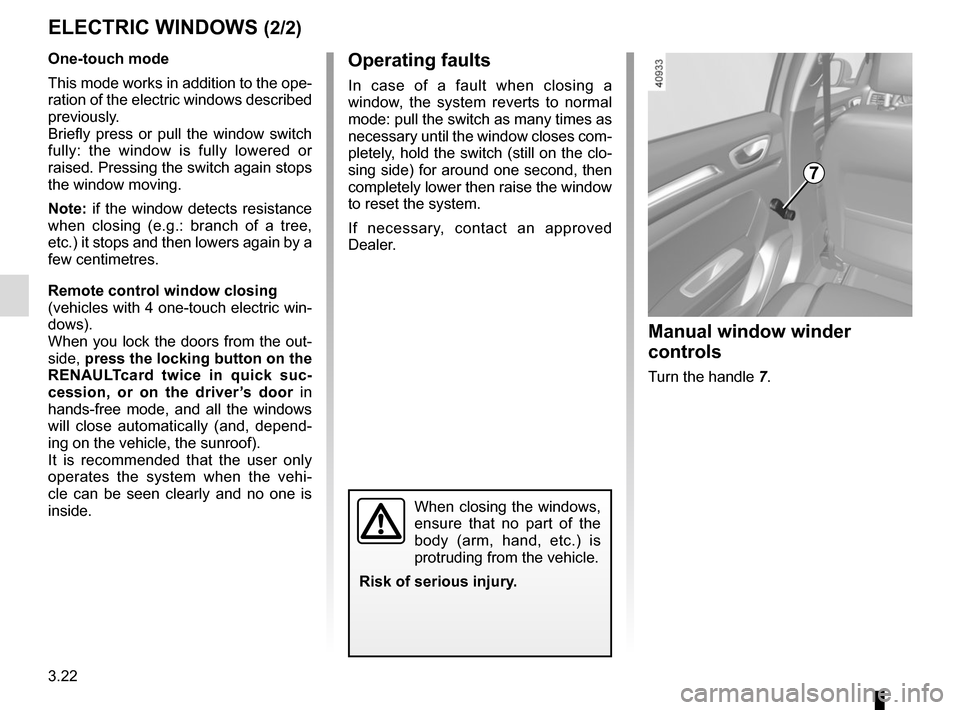
3.22
ELECTRIC WINDOWS (2/2)
Operating faults
In case of a fault when closing a
window, the system reverts to normal
mode: pull the switch as many times as
necessary until the window closes com-
pletely, hold the switch (still on the clo-
sing side) for around one second, then
completely lower then raise the window
to reset the system.
If necessary, contact an approved
Dealer.
When closing the windows,
ensure that no part of the
body (arm, hand, etc.) is
protruding from the vehicle.
Risk of serious injury.
One-touch mode
This mode works in addition to the ope-
ration of the electric windows described
previously.
Briefly press or pull the window switch
fully: the window is fully lowered or
raised. Pressing the switch again stops
the window moving.
Note: if the window detects resistance
when closing (e.g.: branch of a tree,
etc.) it stops and then lowers again by a
few centimetres.
Remote control window closing
(vehicles with 4 one-touch electric win-
dows).
When you lock the doors from the out-
side, press the locking button on the
RENAULTcard twice in quick suc-
cession, or on the driver’s door in
hands-free mode, and all the windows
will close automatically (and, depend-
ing on the vehicle, the sunroof).
It is recommended that the user only
operates the system when the vehi-
cle can be seen clearly and no one is
inside.
7
Manual window winder
controls
Turn the handle 7.
Page 218 of 346
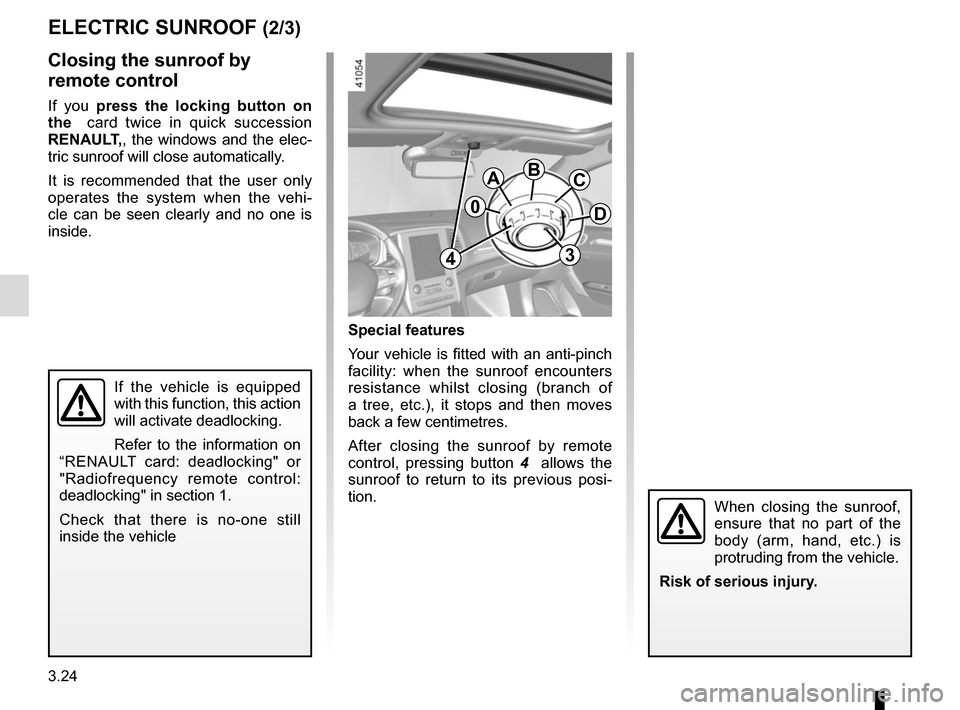
3.24
ELECTRIC SUNROOF (2/3)
Special features
Your vehicle is fitted with an anti-pinch
facility: when the sunroof encounters
resistance whilst closing (branch of
a tree, etc.), it stops and then moves
back a few centimetres.
After closing the sunroof by remote
control, pressing button 4 allows the
sunroof to return to its previous posi-
tion.
Closing the sunroof by
remote control
If you press the locking button on
the card twice in quick succession
RENAULT,, the windows and the elec-
tric sunroof will close automatically.
It is recommended that the user only
operates the system when the vehi-
cle can be seen clearly and no one is
inside.
If the vehicle is equipped
with this function, this action
will activate deadlocking.
Refer to the information on
“RENAULT card: deadlocking" or
"Radiofrequency remote control:
deadlocking" in section 1.
Check that there is no-one still
inside the vehicle
0
ABC
D
34
When closing the sunroof,
ensure that no part of the
body (arm, hand, etc.) is
protruding from the vehicle.
Risk of serious injury.
Page 222 of 346

3.28
Ticket holder 4
Can be used to hold motorway toll tick-
ets, maps, etc.
SUN VISOR, BLINDS
Front sun visor
Lower the sun visor 1 on the wind-
screen or unclip it and lower it over the
side window.
Vanity mirror
Lift the cover 3.
The light 2 switches on automatically.
2
3
When driving, ensure the
courtesy mirror cover is
closed. Risk of injury.
4
1
Page 232 of 346
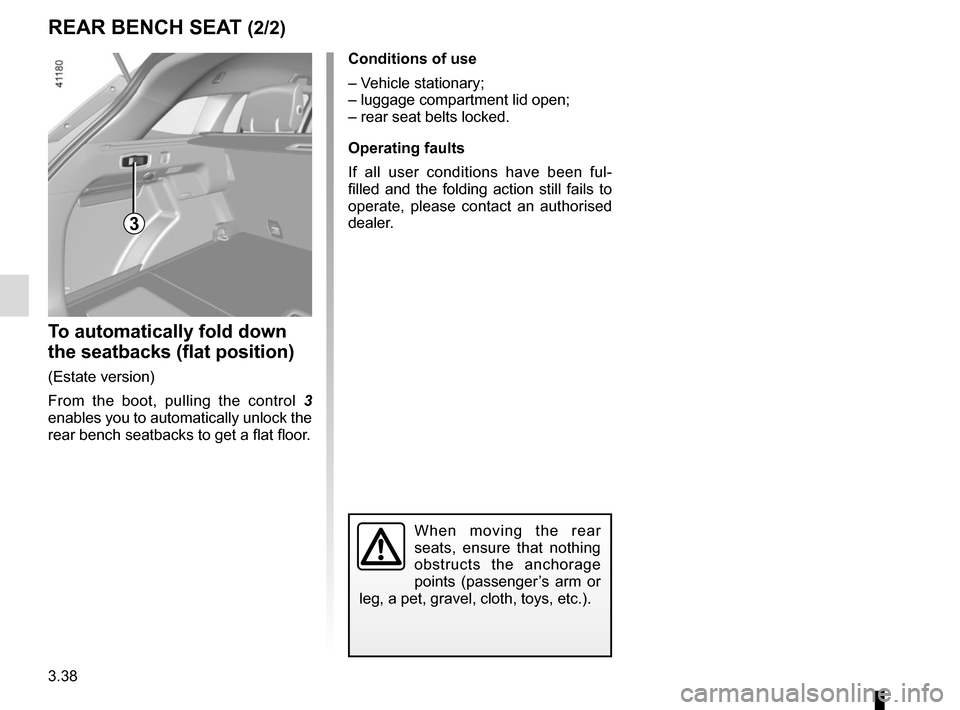
3.38
REAR BENCH SEAT (2/2)
To automatically fold down
the seatbacks (flat position)
(Estate version)
From the boot, pulling the control 3
enables you to automatically unlock the
rear bench seatbacks to get a flat floor.
3
When moving the rear
seats, ensure that nothing
obstructs the anchorage
points (passenger’s arm or
leg, a pet, gravel, cloth, toys, etc.).
Conditions of use
– Vehicle stationary;
– luggage compartment lid open;
– rear seat belts locked.
Operating faults
If all user conditions have been ful-
filled and the folding action still fails to
operate, please contact an authorised
dealer.
Page 233 of 346

3.39
LUGGAGE COMPARTMENT: 4 DOOR VERSION (1/3)
2
Manual controls
To open
Depending on the vehicle, press the
dashboard control 1 or the button 2, the
tailgate opens automatically.
Note: before opening the luggage com-
partment lid, ensure that the surroun-
ding space is sufficient to permit ope-
ration of the luggage compartment lid.
To close
Lower the boot lid using the handle
inside the boot to assist you.
Ensure that nobody is close
to the moving parts when
opening/closing the boot lid.
Risk of injury.
When opening or closing the lug-
gage compartment lid, ensure that
nothing obstructs the manoeuvre.
As a safety precaution,
the doors should only be
opened or closed when the
vehicle is stationary.
Risk of injury.
Depending on the vehicle, there are
various ways to unlock and operate the
luggage compartment lid:
– via the external boot lid control;
– using the hands-free function;
– using the dashboard control.
1
Page 235 of 346
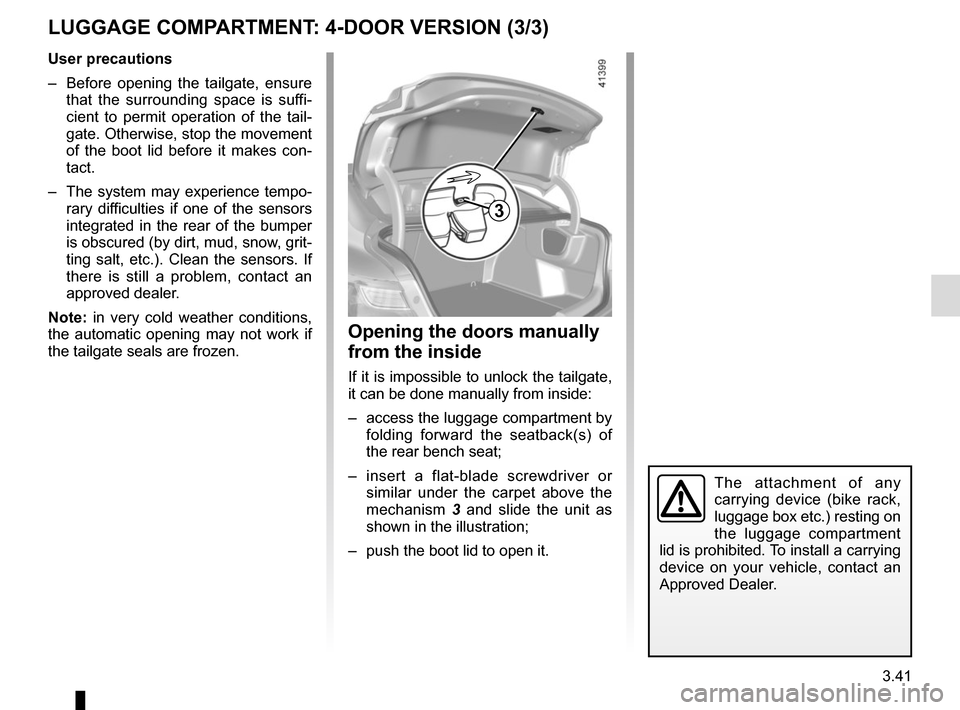
3.41
Opening the doors manually
from the inside
If it is impossible to unlock the tailgate,
it can be done manually from inside:
– access the luggage compartment by folding forward the seatback(s) of
the rear bench seat;
– insert a flat-blade screwdriver or similar under the carpet above the
mechanism 3 and slide the unit as
shown in the illustration;
– push the boot lid to open it.
3
User precautions
– Before opening the tailgate, ensure that the surrounding space is suffi-
cient to permit operation of the tail-
gate. Otherwise, stop the movement
of the boot lid before it makes con-
tact.
– The system may experience tempo- rary difficulties if one of the sensors
integrated in the rear of the bumper
is obscured (by dirt, mud, snow, grit-
ting salt, etc.). Clean the sensors. If
there is still a problem, contact an
approved dealer.
Note: in very cold weather conditions,
the automatic opening may not work if
the tailgate seals are frozen.
LUGGAGE COMPARTMENT: 4-DOOR VERSION (3/3)
The attachment of any
carrying device (bike rack,
luggage box etc.) resting on
the luggage compartment
lid is prohibited. To install a carrying
device on your vehicle, contact an
Approved Dealer.
Page 255 of 346

4.3
BONNET (2/2)
Closing the bonnet
Check that nothing has been left in the
engine compartment.
To close the bonnet again, hold the
bonnet in the middle and guide it down,
allowing a 30 cm gap before it is closed,
then release it. It will latch automatically
under its own weight.
Ensure that the bonnet is
properly locked.
Check that nothing is pre-
venting the catch from lock-
ing (gravel, cloth, etc.).
After carrying out any work
in the engine compart-
ment, check that nothing
has been left behind (cloth,
tools, etc.).
These may damage the engine or
cause a fire.
In the event of even a slight
impact involving the radia-
tor grille or bonnet, have the
bonnet lock checked by an
authorised dealer as soon as pos-
sible.
Page 307 of 346

5.37
TOWING: breakdown recovery (1/2)
Before towing, put the gearbox in neu-
tral, unlock the steering column and re-
lease the parking brake.
For vehicles fitted with an automatic
gearbox, if it is not possible to put the
gear lever into position N, please con-
sult an authorised dealer.
Steering column unlocking
Insert the key into the ignition or, de-
pending on the vehicle, having the
RENAULT card on you, press the
engine start button for 2 seconds.
Reposition the lever to neutral (posi-
tion N for vehicles fitted with an auto-
matic gearbox).
The column is unlocked, the acces-
sory functions are supplied: the vehi-
cle lights can be used (indicators, brake
lights etc.). At night the vehicle must
have its lights on.
Depending on the vehicle, once you
have finished towing, press the engine
start button twice (risk of running down
the battery). The speed specified by current legis-
lation for towing must always be ob-
served. If your vehicle is the towing
vehicle, do not exceed the maximum
towing weight for your vehicle (refer
to the information on “Weights” in
Section 6).
Towing a vehicle with an
automatic gearbox
Transport the vehicle on a trailer or tow
it with the front wheels off the ground.
In exceptional circumstances
, you
may tow it with all four wheels on the
ground, only in a forward gear, with the
gear in neutral position N over a maxi-
mum distance of 50 miles and not ex-
ceeding a speed of 15 mph (25 km/h).
1
2
Do not remove the key from
the ignition when the vehi-
cle is being towed.
If the lever is stuck in P , even though
you are depressing the brake pedal, the
lever can be released manually.
To do this, unclip the base of the lever,
then insert a tool (with a hard rod to it)
into the slot 1 and press the button 2
at the same time in order to unlock the
lever.
Contact an authorised dealer as soon
as possible.
Page 339 of 346
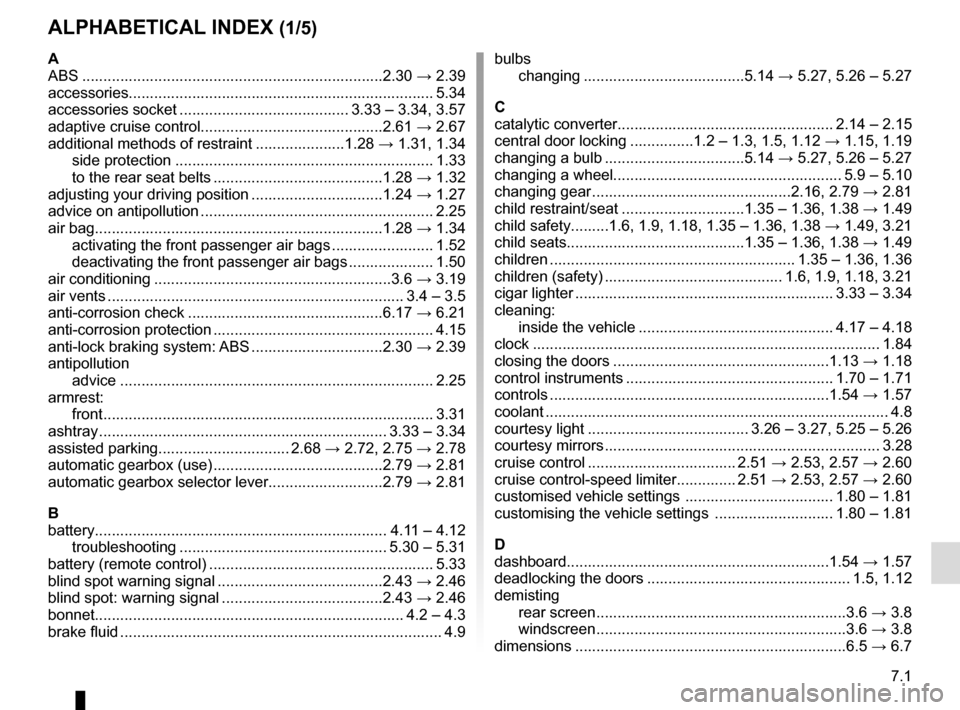
7.1
ALPHABETICAL INDEX (1/5)
A
ABS ....................................................................\
...2.30 → 2.39
accessories........................................................................\
5.34
accessories socket ........................................ 3.33 – 3.34, 3.57
adaptive cruise control...........................................2.61 → 2.67
additional methods of restraint .....................1.28 → 1.31, 1.34
side protection ............................................................. 1.33
to the rear seat belts ........................................1.28 → 1.32
adjusting your driving position ...............................1.24 → 1.27
advice on antipollution ....................................................... 2.25
air bag....................................................................1.28 → 1.34
activating the front passenger air bags ........................ 1.52
deactivating the front passenger air bags .................... 1.50
air conditioning ........................................................3.6 → 3.19
air vents ...................................................................... 3.4 – 3.5
anti-corrosion check ..............................................6.17 → 6.21
anti-corrosion protection .................................................... 4.15
anti-lock braking system: ABS ...............................2.30 → 2.39
antipollution advice .................................................................\
......... 2.25
armrest: front ..................................................................\
............ 3.31
ashtray .................................................................... 3.33 – 3.34
assisted parking............................... 2.68 → 2.72, 2.75 → 2.78
automatic gearbox (use) ........................................2.79 → 2.81
automatic gearbox selector lever...........................2.79 → 2.81
B
battery..................................................................... 4.11 – 4.12 troubleshooting ................................................. 5.30 – 5.31
battery (remote control) ..................................................... 5.33
blind spot warning signal .......................................2.43 → 2.46
blind spot: warning signal ......................................2.43 → 2.46
bonnet........................................................................\
. 4.2 – 4.3
brake fluid ........................................................................\
.... 4.9 bulbs
changing ......................................5.14 → 5.27, 5.26 – 5.27
C
catalytic converter................................................... 2.14 – 2.15
central door locking ...............1.2 – 1.3, 1.5, 1.12 → 1.15, 1.19
changing a bulb .................................5.14 → 5.27, 5.26 – 5.27
changing a wheel...................................................... 5.9 – 5.10
changing gear ...............................................2.16, 2.79 → 2.81
child restraint/seat .............................1.35 – 1.36, 1.38 → 1.49
child safety.........1.6, 1.9, 1.18, 1.35 – 1.36, 1.38 → 1.49, 3.21
child seats..........................................1.35 – 1.36, 1.38 → 1.49
children .......................................................... 1.35 – 1.36, 1.36
children (safety) .......................................... 1.6, 1.9, 1.18, 3.21
cigar lighter ............................................................. 3.33 – 3.34
cleaning: inside the vehicle .............................................. 4.17 – 4.18
clock ..................................................................\
................ 1.84
closing the doors ...................................................1.13 → 1.18
control instruments ................................................. 1.70 – 1.71
controls ...............................................................\
...1.54 → 1.57
coolant ................................................................\
................. 4.8
courtesy light ...................................... 3.26 – 3.27, 5.25 – 5.26
courtesy mirrors ................................................................. 3.28
cruise control ................................... 2.51 → 2.53, 2.57 → 2.60
cruise control-speed limiter.............. 2.51 → 2.53, 2.57 → 2.60
customised vehicle settings ................................... 1.80 – 1.81
customising the vehicle settings ............................ 1.80 – 1.81
D
dashboard..............................................................1.54 → 1.57
deadlocking the doors ................................................ 1.5, 1.12
demisting rear screen ...........................................................3.6 →
3.8
windscreen ...........................................................3.6 → 3.8
dimensions .............................................................\
...6.5 → 6.7